最新译林版6bunit1教案
2024年最新译林版6bunit1教案
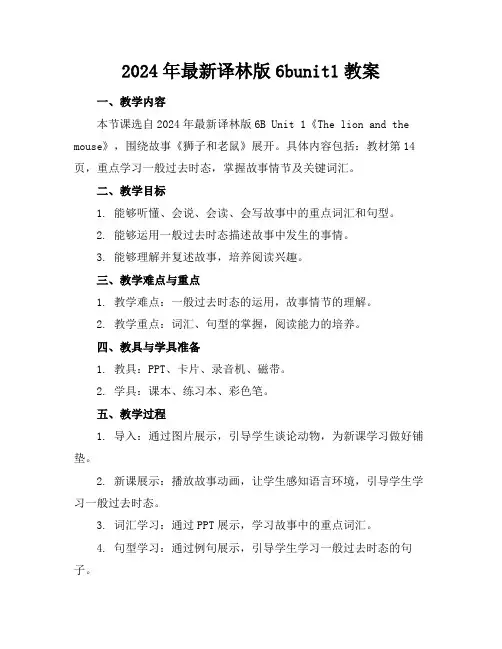
2024年最新译林版6bunit1教案一、教学内容本节课选自2024年最新译林版6B Unit 1《The lion and the mouse》,围绕故事《狮子和老鼠》展开。
具体内容包括:教材第14页,重点学习一般过去时态,掌握故事情节及关键词汇。
二、教学目标1. 能够听懂、会说、会读、会写故事中的重点词汇和句型。
2. 能够运用一般过去时态描述故事中发生的事情。
3. 能够理解并复述故事,培养阅读兴趣。
三、教学难点与重点1. 教学难点:一般过去时态的运用,故事情节的理解。
2. 教学重点:词汇、句型的掌握,阅读能力的培养。
四、教具与学具准备1. 教具:PPT、卡片、录音机、磁带。
2. 学具:课本、练习本、彩色笔。
五、教学过程1. 导入:通过图片展示,引导学生谈论动物,为新课学习做好铺垫。
2. 新课展示:播放故事动画,让学生感知语言环境,引导学生学习一般过去时态。
3. 词汇学习:通过PPT展示,学习故事中的重点词汇。
4. 句型学习:通过例句展示,引导学生学习一般过去时态的句子。
5. 故事学习:分角色朗读故事,让学生理解并掌握故事情节。
6. 随堂练习:设计填空、选择、连线等题型,巩固所学知识。
7. 小组活动:分组讨论,让学生运用一般过去时态描述故事中的情节。
六、板书设计1. 《The lion and the mouse》2. 重点词汇:mouse, lion, hole, net, noise, large, small, sorry, help3. 重点句型:The lion was sleeping in his cave. The mouse bit the net with his teeth.七、作业设计1. 作业题目:(1)抄写本节课的重点词汇和句型。
(2)运用一般过去时态,描述故事中一个有趣的情节。
(3)复述故事,用自己的话进行改编。
答案:(1)见板书设计。
(2)例:Yesterday, the lion was walking in the forest. He saw a mouse and wanted to eat it. But the mouse begged for his life and said, "Please don't eat me. One day I may be able to help you." The lion laughed and let the mouse go.(3)略。
译林版 小学英语 6B Unit1 The lion and the mouse.docx 2.19
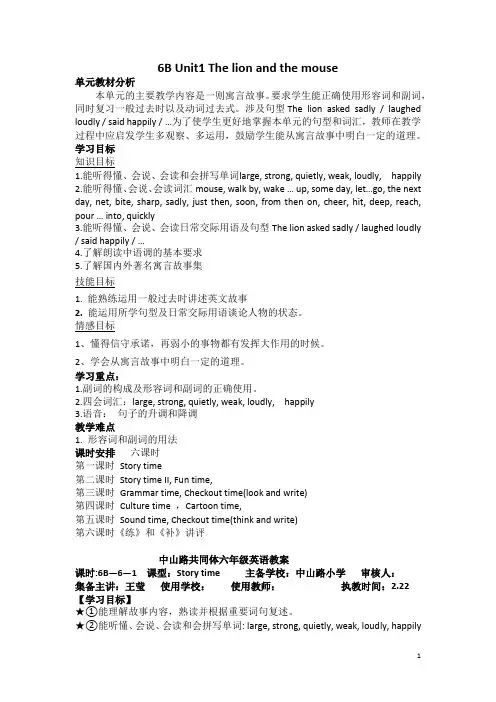
6B Unit1 The lion and the mouse单元教材分析本单元的主要教学内容是一则寓言故事。
要求学生能正确使用形容词和副词,同时复习一般过去时以及动词过去式。
涉及句型The lion asked sadly / laughed loudly / said happily / …为了使学生更好地掌握本单元的句型和词汇,教师在教学过程中应启发学生多观察、多运用,鼓励学生能从寓言故事中明白一定的道理。
学习目标知识目标1.能听得懂、会说、会读和会拼写单词large, strong, quietly, weak, loudly, happily2.能听得懂、会说、会读词汇mouse, walk by, wake … up, some day, let…go, the next day, net, bite, sharp, sadly, just then, soon, from then on, cheer, hit, deep, reach, pour … into, quickly3.能听得懂、会说、会读日常交际用语及句型The lion asked sadly / laughed loudly / said happily / …4.了解朗读中语调的基本要求5.了解国内外著名寓言故事集技能目标1. 能熟练运用一般过去时讲述英文故事2. 能运用所学句型及日常交际用语谈论人物的状态。
情感目标1、懂得信守承诺,再弱小的事物都有发挥大作用的时候。
2、学会从寓言故事中明白一定的道理。
学习重点:1.副词的构成及形容词和副词的正确使用。
2.四会词汇:large, strong, quietly, weak, loudly, happily3.语音:句子的升调和降调教学难点1. 形容词和副词的用法课时安排六课时第一课时Story time第二课时Story time II, Fun time,第三课时Grammar time, Checkout time(look and write)第四课时Culture time ,Cartoon time,第五课时Sound time, Checkout time(think and write)第六课时《练》和《补》讲评中山路共同体六年级英语教案课时:6B—6—1 课型:Story time 主备学校:中山路小学审核人:集备主讲:王莹使用学校:使用教师:执教时间:2.22【学习目标】★①能理解故事内容,熟读并根据重要词句复述。
译林英语6B第一单元教案
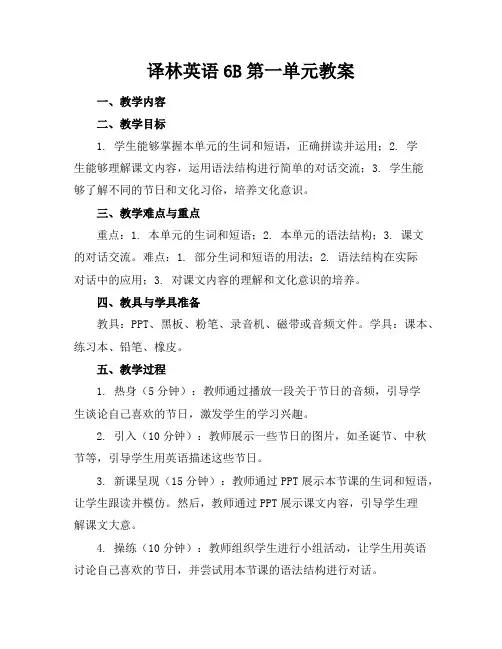
译林英语6B第一单元教案一、教学内容二、教学目标1. 学生能够掌握本单元的生词和短语,正确拼读并运用;2. 学生能够理解课文内容,运用语法结构进行简单的对话交流;3. 学生能够了解不同的节日和文化习俗,培养文化意识。
三、教学难点与重点重点:1. 本单元的生词和短语;2. 本单元的语法结构;3. 课文的对话交流。
难点:1. 部分生词和短语的用法;2. 语法结构在实际对话中的应用;3. 对课文内容的理解和文化意识的培养。
四、教具与学具准备教具:PPT、黑板、粉笔、录音机、磁带或音频文件。
学具:课本、练习本、铅笔、橡皮。
五、教学过程1. 热身(5分钟):教师通过播放一段关于节日的音频,引导学生谈论自己喜欢的节日,激发学生的学习兴趣。
2. 引入(10分钟):教师展示一些节日的图片,如圣诞节、中秋节等,引导学生用英语描述这些节日。
3. 新课呈现(15分钟):教师通过PPT展示本节课的生词和短语,让学生跟读并模仿。
然后,教师通过PPT展示课文内容,引导学生理解课文大意。
4. 操练(10分钟):教师组织学生进行小组活动,让学生用英语讨论自己喜欢的节日,并尝试用本节课的语法结构进行对话。
5. 巩固(10分钟):教师通过PPT展示一些练习题,让学生独立完成,检查学生对课文内容和语法结构的理解。
7. 拓展(5分钟):教师引导学生谈论其他国家的节日,让学生了解不同的文化习俗。
六、板书设计板书设计如下:节日描述圣诞节 It's on December 25th. People usually have a big meal and give presents.中秋节 It's on the 15th of the eighth lunar month. People usually eat mooncakes and watch the moon.七、作业设计1. 抄写本节课的生词和短语,并模仿造句;2. 根据课文内容,写一篇关于自己喜欢的节日的短文;3. 跟家长或朋友用英语谈论一下我国的春节,并记录下来。
译林版,小学英语6BUnit1复习教案
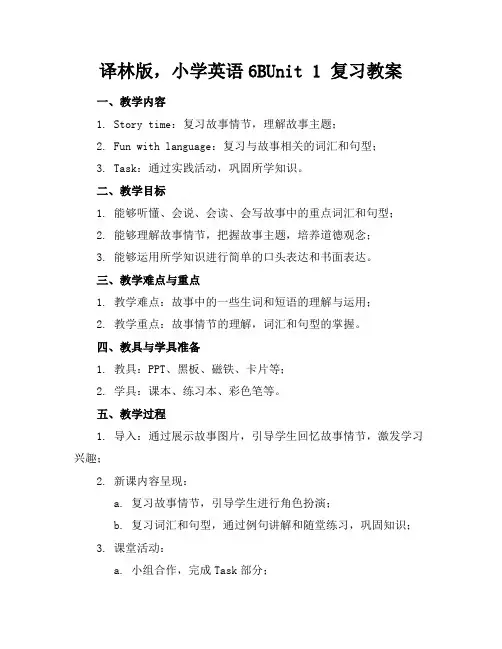
译林版,小学英语6BUnit 1 复习教案一、教学内容1. Story time:复习故事情节,理解故事主题;2. Fun with language:复习与故事相关的词汇和句型;3. Task:通过实践活动,巩固所学知识。
二、教学目标1. 能够听懂、会说、会读、会写故事中的重点词汇和句型;2. 能够理解故事情节,把握故事主题,培养道德观念;3. 能够运用所学知识进行简单的口头表达和书面表达。
三、教学难点与重点1. 教学难点:故事中的一些生词和短语的理解与运用;2. 教学重点:故事情节的理解,词汇和句型的掌握。
四、教具与学具准备1. 教具:PPT、黑板、磁铁、卡片等;2. 学具:课本、练习本、彩色笔等。
五、教学过程1. 导入:通过展示故事图片,引导学生回忆故事情节,激发学习兴趣;2. 新课内容呈现:a. 复习故事情节,引导学生进行角色扮演;b. 复习词汇和句型,通过例句讲解和随堂练习,巩固知识;3. 课堂活动:a. 小组合作,完成Task部分;b. 个人展示,进行口头表达;六、板书设计1. 故事《The lion and the mouse》2. 重点词汇:big, small, strong, weak, help, laugh等;3. 重点句型:The lion is big and strong. The mouse is small and weak.等;4. Task部分:用思维导图展示故事情节。
七、作业设计1. 作业题目:根据故事情节,用英语写一篇短文;2. 答案示例:One day, a lion caught a mouse. The lion wanted to eat the mouse, but the mouse said, "Please don't eat me. If you let me go, I'll help you one day." The lion laughed and let the mouse go. Some time later, the lion got trapped in a net. The mouse heard the lion's roar and came to help. The mouse bit the net and set the lion free. The lion was very grateful to the mouse.八、课后反思及拓展延伸2. 拓展延伸:鼓励学生阅读其他寓言故事,提高英语阅读兴趣和水平。
最新译林版6bunit1教案
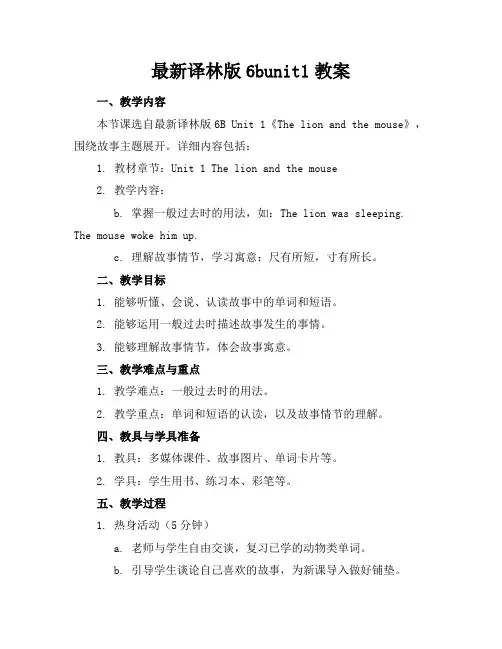
最新译林版6bunit1教案一、教学内容本节课选自最新译林版6B Unit 1《The lion and the mouse》,围绕故事主题展开。
详细内容包括:1. 教材章节:Unit 1 The lion and the mouse2. 教学内容:b. 掌握一般过去时的用法,如:The lion was sleeping. The mouse woke him up.c. 理解故事情节,学习寓意:尺有所短,寸有所长。
二、教学目标1. 能够听懂、会说、认读故事中的单词和短语。
2. 能够运用一般过去时描述故事发生的事情。
3. 能够理解故事情节,体会故事寓意。
三、教学难点与重点1. 教学难点:一般过去时的用法。
2. 教学重点:单词和短语的认读,以及故事情节的理解。
四、教具与学具准备1. 教具:多媒体课件、故事图片、单词卡片等。
2. 学具:学生用书、练习本、彩笔等。
五、教学过程1. 热身活动(5分钟)a. 老师与学生自由交谈,复习已学的动物类单词。
b. 引导学生谈论自己喜欢的故事,为新课导入做好铺垫。
2. 新课导入(10分钟)a. 利用多媒体课件展示故事图片,引导学生预测故事情节。
b. 分组讨论,每组选一个代表进行预测分享。
3. 故事学习(15分钟)a. 老师播放故事录音,学生跟随录音朗读。
b. 老师讲解故事中的单词和短语,帮助学生理解。
c. 学生分角色朗读故事。
4. 例题讲解(10分钟)a. 老师给出例句,讲解一般过去时的用法。
b. 学生模仿例句,进行句子练习。
5. 随堂练习(10分钟)a. 学生完成练习本上的句子练习。
b. 老师挑选部分学生进行展示,给予评价和指导。
6. 小结与拓展(5分钟)b. 学生谈论故事寓意,进行情感教育。
六、板书设计1. The lion and the mouse3. 句子:The lion was sleeping. The mouse woke him up.七、作业设计a. The lion was sleeping in the forest.b. The mouse ______ (叫醒) the lion.c. The lion ______ (笑) at the mouse.2. 答案:a. The lion was sleeping in the forest.b. The mouse woke up the lion.c. The lion laughed at the mouse.八、课后反思及拓展延伸1. 学生对故事情节的理解程度,以及对一般过去时的掌握情况。
译林版六年级英语第一单元教案【可编辑】
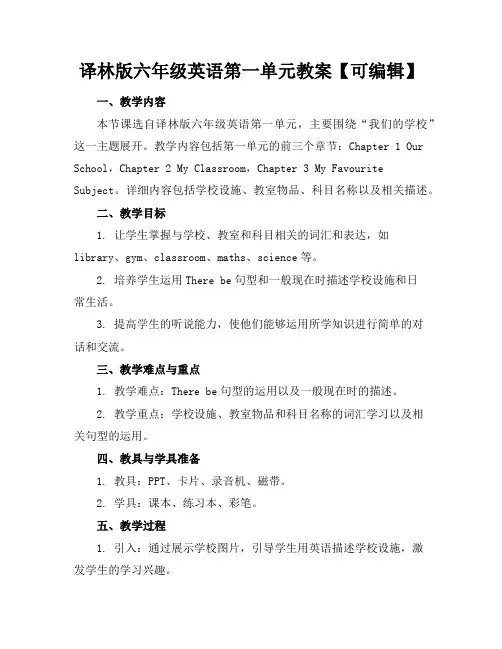
译林版六年级英语第一单元教案【可编辑】一、教学内容本节课选自译林版六年级英语第一单元,主要围绕“我们的学校”这一主题展开。
教学内容包括第一单元的前三个章节:Chapter 1 Our School,Chapter 2 My Classroom,Chapter 3 My Favourite Subject。
详细内容包括学校设施、教室物品、科目名称以及相关描述。
二、教学目标1. 让学生掌握与学校、教室和科目相关的词汇和表达,如library、gym、classroom、maths、science等。
2. 培养学生运用There be句型和一般现在时描述学校设施和日常生活。
3. 提高学生的听说能力,使他们能够运用所学知识进行简单的对话和交流。
三、教学难点与重点1. 教学难点:There be句型的运用以及一般现在时的描述。
2. 教学重点:学校设施、教室物品和科目名称的词汇学习以及相关句型的运用。
四、教具与学具准备1. 教具:PPT、卡片、录音机、磁带。
2. 学具:课本、练习本、彩笔。
五、教学过程1. 引入:通过展示学校图片,引导学生用英语描述学校设施,激发学生的学习兴趣。
2. 新课导入:呈现Chapter 1 Our School的内容,学习学校设施相关的词汇和表达,如library、gym、playground等。
3. 例题讲解:讲解There be句型的用法,通过例句展示,让学生模仿并练习。
4. 随堂练习:分组进行对话练习,描述学校设施。
5. 学习Chapter 2 My Classroom,掌握教室物品的词汇,如desk、chair、blackboard等。
6. 运用一般现在时描述日常学习生活,如“I like maths.”。
7. 学习Chapter 3 My Favourite Subject,了解科目名称和相关描述。
8. 小组活动:讨论最喜欢的科目,并进行汇报。
六、板书设计1. 词汇:学校设施、教室物品、科目名称。
译林英语6B第一单元教案
译林英语6B第一单元教案一、教学内容二、教学目标1. 让学生了解并掌握澳大利亚的相关文化知识,提高学生的国际视野。
2. 培养学生运用一般现在时态进行描述的能力,增强语言表达能力。
3. 提高学生的词汇量,学会使用相关词汇描述澳大利亚的特色。
三、教学难点与重点1. 教学难点:一般现在时态的运用,以及相关词汇的正确拼写。
2. 教学重点:澳大利亚文化特色的了解和表达,一般现在时态的运用。
四、教具与学具准备1. 教具:PPT、图片、视频、黑板、粉笔等。
2. 学具:教材、练习本、彩色笔等。
五、教学过程1. 导入:通过展示澳大利亚风景图片,引发学生对澳大利亚的兴趣,导入新课。
2. 新课内容展示:利用PPT、图片和视频,介绍澳大利亚的地理、动物、景点等文化特色,引导学生学习新词汇和一般现在时态。
3. 例题讲解:针对一般现在时态,给出例句,进行讲解和练习。
4. 随堂练习:让学生运用新学的词汇和语法,进行小组讨论,描述澳大利亚的特色。
六、板书设计1. An interesting country2. 主要内容:澳大利亚地理、动物、景点介绍一般现在时态的运用新词汇:koala, kangaroo, Sydney Opera House等七、作业设计1. 作业题目:(1)用一般现在时态描述澳大利亚的一种动物或景点。
(2)编写一段关于澳大利亚的短文,至少使用5个新词汇。
2. 答案:(1)The kangaroo is a kind of animal that can jump very high.(2)Australia is an interesting country. It has many unique animals, such as koalas and kangaroos. The Sydney Opera House is a famous landmark of Australia.八、课后反思及拓展延伸重点和难点解析1. 教学内容的准确性和深度2. 教学目标的明确性和可衡量性3. 教学难点与重点的识别与处理4. 教学过程的实践情景引入和随堂练习设计5. 作业设计的针对性和答案的准确性6. 课后反思与拓展延伸的实际操作一、教学内容的准确性和深度教学内容应确保准确无误,同时要深入挖掘澳大利亚的文化特色,不仅仅局限于表面的介绍。
译林小学英语6B 第1单元教案 5课时
Unit 1 The lion and the mouseThe 1st period 一、教学内容:Unit 1 The lion and the mouse Story time二、教学目标:1.能理解并会朗读故事,初步说出故事大意。
2.在故事学习过程中掌握large, strong, woke, weak, net, bit, sharp等新单词,体会副词sadly, quietly, loudly, happily的用法。
3.通过学习本课的故事,让学生懂得人与人之间应该互相帮助。
三、教学重点:在故事中通过读体会副词sadly, quietly, loudly, happily的用法。
四、教学难点:能从不同角度理解故事的寓意。
五、教学准备:PPT,动物头饰六、教学过程Step 1: Greeting and Lead-in1. GreetingT: Hi, boys and girls. Welcome back to school again.2. Learning tipsT: This is a new term now. And it’s the last term in your primary school time. So first of all, today let’s talk about your study plan for this term. What’s your study plan?3. Lead –inT: Here’s a study plan. Can you read this plan?T: Look, in this plan, the planner wants to spend more time on reading English. Indeed, reading is very important. And story reading is very good for English learning. So today, I bring you a story.Step 2 Presentation1. 30-second’s talk showT: This story is about two different animals. (PPT)The name of the story is The lion and the mouse. (课题)Before the story, I want you to be one of them and try to say something. (教师示范,学生练习并反馈)2. PredictionT: Yes, As you all know, the lion and the mouse are very different, aren’t you? What if they met each other one day? Can you guess?T: Let’s watch a cartoon and see what happens. (学生看后预测)3. Read and orderT: Nice. Now you know what happens. Here are some sentences, but they are not in order. Can you read your story on your book quickly and put then in order?T: Now they are in order. But here’s a problem. Even if they are in the right order, this story is still not completed. So can you read this story again and try to say three more sentences to complete this story?4. Read the story picture by pictureT: Now we’ve got the outline of the story. Let’s listen and read this story by picture. Please listen and try to follow what you hear.(教授:单词词组)5.Ask and answerT: Now we’ve got every details of the story. Let me ask you some question and please answer me quickly.T: There are 5 questions on your book. But I want you to ask and answer more. Now you can read the story again and prepare some questions?Step 3 Consolidation1. The moral or the storyT: What does this story tell us?T: I have 3 questions to help you think in different ways.Read and try to say something,2. 3-minute’s talk show.Step 4 Homework1. Make a study plan.2.听磁带,有感情地模仿熟读课文并尝试背诵。
译林版,小学英语6BUnit 1 复习教案
Unit 1 The lion and the mouse(复习)Teaching contents 教学内容复习story,Grammar time & Fun timeTeaching aims and learning objectives 教学目标1. 能熟练背诵story。
2. 能正确恰当地运用副词修饰动词。
3. 能生动形象地表演Fun time中的课本剧。
Focus of the lesson and predicted area of difficulty 教学重点和难点:教学重点:能正确恰当地运用副词修饰动词。
教学难点:能在Fun time课本剧表演中体现出副词的功能性。
Teaching procedures 教学过程:Step 1 Let’s reviewT: Hi, boys and girls. Look, who’s he?(出示狮子和老鼠头像)T: Who’s strong?S: The lion.T: Wh o’s weak?S: The mouse.But after we learned the story, do you still think that the mouse is always weak? Why? T: Tha t’s right. And the second tip is that these pictures can help us remember the story. So you can look at the pictures and tell the story. Now, please do it in pairs.(学生同桌讲故事)T: This time let’s tell the story in class. Everybody says one or two sentences and let another person go on. Start from me: There was a lion in the forest. He was large and strong. One day …(请学生逐个复述,接龙完成故事)Step 2 Grammar time1. Read and feelT: In this story, the mouse and the lion said something. What did they say? How did they feel at that time? Can you try to read and feel? (学生自己读并感受)T: The mouse was very little, and he was scared, so how did he say it? Can you guess? T: So who can be the mouse and say it quietly? (引导学生夸张读)The mouse said quietly, but how about the large lion? How did he laugh?T: But when he was in the net, was he happy? How did he say?T: After the mouse helped the lion, how did the lion feel? So how did he say?T: The lion and the mouse had different feelings at different times. Let’s read and feel!2. review the adverbsT:Just now we used these four words.S: Quietly, loudly, sadly and happily.T: They are adverbs. (带读,板书)We can say ‘The mouse said.’ It’s OK. But why do we say ‘The mouse said quietly.’ What are the adverbs for?S: (引导学生)They can show the actions more vividly.T: And look(板书), do we often put them before or after the verbs?S: we often put adverbs after the verbs.T: And we can get some adverbs from the adjectives. (学生快速说,读词,贴板书。
译林版,小学英语6BUnit1复习教案
译林版,小学英语6BUnit 1 复习教案一、教学内容本节课为译林版小学英语6B Unit 1的复习课。
教材内容包括:课文对话、单词、短语、语法点以及相关文化背景知识。
课文对话涉及日常交流用语,单词和短语围绕主题展开,语法点为一般现在时态,文化背景知识介绍英语国家的日常问候习惯。
二、教学目标1. 学生能够熟练朗读课文,理解课文内容,运用所学单词、短语进行日常交流。
2. 学生能够正确运用一般现在时态描述自己的日常作息。
3. 学生能够了解英语国家的日常问候习惯,提高跨文化交际能力。
三、教学难点与重点1. 教学难点:一般现在时态的运用,单词和短语的灵活运用。
2. 教学重点:课文对话的朗读与理解,一般现在时态的掌握。
四、教具与学具准备1. 教具:多媒体课件、黑板、粉笔、录音机、磁带。
2. 学具:课本、练习册、单词卡片、录音机、磁带。
五、教学过程1. 热身(5分钟)教师与学生进行简单的英语交流,引导学生复习日常问候语。
2. 课文复习(10分钟)教师带领学生朗读课文,引导学生理解课文内容,回答相关问题。
3. 单词和短语复习(10分钟)教师出示单词和短语,引导学生跟读,并用例句展示其用法。
4. 语法点复习(10分钟)教师通过例句讲解一般现在时态的用法,引导学生进行句子练习。
5. 小组活动(10分钟)学生分组,运用所学单词、短语和语法点进行日常对话练习。
教师引导学生回顾本节课所学内容,巩固知识点。
六、板书设计1. 课文对话关键词:问候、日常活动、一般现在时态。
2. 单词和短语:morning、afternoon、evening、hello、how are you、what's your name、my name is、nice to meet you。
3. 语法点:一般现在时态结构:主语+动词原形。
七、作业设计1. 作业题目:(1)抄写本节课所学生词和短语。
(2)用一般现在时态描述自己的日常作息。
(3)与同学用英语进行日常问候交流,并记录下来。
- 1、下载文档前请自行甄别文档内容的完整性,平台不提供额外的编辑、内容补充、找答案等附加服务。
- 2、"仅部分预览"的文档,不可在线预览部分如存在完整性等问题,可反馈申请退款(可完整预览的文档不适用该条件!)。
- 3、如文档侵犯您的权益,请联系客服反馈,我们会尽快为您处理(人工客服工作时间:9:00-18:30)。
Unit1 The lion and the mouse、单元分析: 作为本册教材的起始单元,本单元的课文仍旧是一个经典故事,改编自著名的寓言故事《狮 子和老鼠》。
故事以拟人的手法呈现了两个强弱分明的动物形象,表达了两个寓意:一是小 人物也可以发挥大作用;二是人人都需要朋友,即使他很强大。
本单元课文采用一般过去时 叙述故事,在课文教学的最后巩固阶段,和学生一起复习六年级上册第一至第四单元一般过 去时的语法知识,包括规则动词和不规则动词的过去式、一般过去时的一般疑问句和特殊疑 问句以及相关的时间状语。
二、学情分析:本单元以寓言故事作为载体, 很好地再现了一般过去式的用法, 以激发学生的兴趣为导入点。
本单元的重难点是一般过去时中动词的过去式变换形式,特别是动词的不规则变化,还有就 是形容词转换成副词的形式。
单纯地讲解语法,不利于激发小学阶段学生兴趣的,因此我以 故事为切入点,回顾一般过去时的用法和副词的转换形式,同时通过朗读和角色扮演的教学 活动,使学生灵活地运用所学内容。
三、教学目标:1、能理解、读并复述故事2、能听懂、会说、会读词汇: bite 、hole 、 large 、 sharp 、 strong 、 weak 、 wake up 、3、能听懂、会说、会读表示时间顺序的词组:the next day 、 just then,from then on4、通过课文学习,能学会互相帮助,不轻视别人。
四、教学重点: 1、能理解、读并复述故事 2、能听懂、会说、会读词汇: bite 、 hole 、 large \sharp\strong\weak\wake up\let go3、能听懂、会说、会读表示时间顺序的词组:五、教学难点: 1、能理解、读并复述故事2、能听懂、会说、会读表示时间顺序的词组:3、 wake-woke,bite-bit六、教学准备: PPT,卡片七、课时安排: 第一课时 Story time 第二课时 Grammar time 、 Fun time 、 Checkout time第三课时 Sound time 第四课时 Culture time 第四课时Revision 第一课时 教学内容:Unit1 The lion and the mouse二、 教学目标: the next day 、 just then,from then onthe next day 、 just then,from then on、 Ticking time、 Cartoon timeStory time )1. 能理解并会朗读故事。
2. 能初步听懂、会读单词large 、strong 、woke、weak、net 、bit 、sharp 、sadly 、hole3. 进一步巩固there be 一般过去时,并注意不规则动词过去式的写法和读音。
4. 通过学习本课的故事,让学生懂得人与人之间应该互相帮助。
三、教学重点:1. 能理解并会朗读故事。
2. 能初步听懂、会读单词3. 进一步巩固there be四、教学难点:large 、strong 、woke、weak、net 、bit 、sharp 、sadly 、hole 一般过去时,并注意不规则动词过去式的写法和读音。
1. 能理解并会朗读故事。
2. 能初步听懂、会读单词3. 进一步巩固there be五、教学准备:large 、strong 、woke、weak、net 、bit 、sharp 、sadly 、hole 一般过去时,并注意不规则动词过去式的写法和读音。
PPT卡片六、教学过程Step 1:Learning aims1. 能理解并会朗读故事。
2. 能初步听懂、会读单词large 、strong 、woke、weak、net 、bit 、sharp 、sadly 、hole4. 通过学习本课的故事,让学生懂得人与人之间应该互相帮助。
Step 2: Pre-reading1. 复习一些过去式的动词(看谁能又快又准地说出下列动词的过去式。
)2. 学习新的动词过去式woke、said 、bie 、Step 3: While-reading1. 用中文说说这个故事的大意2.Read and order , 学生初读课文,完成书后的练习3. Ask and answerWho woke the lion up? Did the lion eat the mouse?How did the men catch the lion? How did the mouse help the lion? What did the lion and the mouse become?4.listen and read5. read in groupsStep 4: Post- reading1 Act it out 根据课文图片和板书试着复述课文。
3. 进一步巩固there be 般过去时,并注意不规则动词过去式的写法和读音。
Step 3:PresentationStep 5:Checkout.1. what do you learn from this story.2. 笔头练习Step 6: Homework.1. 听磁带,有感情地模仿熟读课文并尝试背诵。
2. 和同学脱稿表演 . 七、板书设计:Unit1 The lion and the mouseHappily 狮子图 large strong laugh loudly ask sadly、教学内容:Unit1 The lion and the mouse 二、教学目标:1. 能根据提示复述课文2.3. 能扩充故事,并进行表演4. 三、教学重点:1. 能根据提示复述课文2.3. 能扩充故事,并进行表演4.四、教学难点 ; 1. 能理解形容词和副词的区别 2.五、教学准备:PPT六、教学过程:Step 1:Learning aims 1. 能根据提示复述课文 2. 3. 能扩充故事,并进行表演 4.small weak say quietly第二课时Fun & Grammer time&Culture time)能理解形容词和副词的区别能对中外寓言故事有所了解。
能理解形容词和副词的区别能对中外寓言故事有所了解。
能扩充故事,并进行表演能理解形容词和副词的区别能对中外寓言故事有所了解。
Step 2: Revision1. Review words, sentences in the story.2. Students dub.Fun time老鼠图Grammer time1. 复习五年级学过的复习2. play games 学生快速说出形容词及副词3. 组词比赛ask sadly laugh loudly ..................Culture time学习 this is Aesop ' s Fables.You can find many animal stories in it.This is a Chinese idiom book.Step 4: Practice1. 说说自己读过的寓言故事,并说说其中的道理2. 完成笔头连写Step 5: Homework1. 巩固背诵单词拼写。
2. 表演故事。
七、板书设计:Unit1 The lion and the mouseThe lion ask loudlyUnit1 The lion and the mouse sound time &Cartoon time )教后反思:、教学内容:the mouse say quietly强调动词后加副词say loudly第三课时a. 学生扩充故事并读一读b. 小组表演故事sadlylaugh二、教学目标:1 初步了解特殊疑问句的降调。
2 能正确地理解并朗读对话内容,在教师的引导和帮助下尝试表演对话。
3 通过本课学习,学生能够了解中西方寓言的相同之处。
三、教学重点:能正确地理解并朗读对话内容,在教师的引导和帮助下尝试表演。
四、教学难点:Aesop' s Fable s 和idiom 单词的读音。
五、教学准备:PPT单词卡片六、教学过程:Step 1: Learning aims1 初步了解特殊疑问句的降调。
2 能正确地理解并朗读对话内容,在教师的引导和帮助下尝试表演对话。
3 通过本课学习,学生能够了解中西方寓言的相同之处。
Step 2: Revision1. Review the storyOne day, a ______ mouse woke up the _______ lion. The lion caught the mouse and wanted to eat him. However, the lion ____ the mouse go.The next day, the lion was ___________ by men. The mouse made a hole and saved the lion. From ____ on, the lion and the mouse became friends.Step 3:Presentation & practice1. 看动画,完成练习( ) 1. Sam is good at table tennis.( ) 2. Bobby hits the ball hard.( ) 3. Sam and Bobby find a hole in the playground.( ) 4. Sam can reach the ball in the hole.2. 在阅读中解决部分生词3. 自己读,回答问题a. What do Billy and Willy do near the table?b. What is Sam ' s idea?4. Read after the computer.5. Let ' s act.Step 4: ProductionSound time1. Have a talkTalk about the picture of sound time2. Listen and repeatRead after the computerStep 5: Checkout.笔头练习Step 6: Homework1. 朗读cartoon time 。
2. 抄写四会单词。
3. 练习。
七、板书设计:Unit1 The lion and the mouse say-said happy-happily is-was catch-caught bite-bit ask-asked let-let see-saw make-made第四课时一、教学内容:Unit1 The lion and the mouse (Ticking time & 复习)二、教学目标:1. 能复述和进一步理解The lion and the mouse 的故事和其中的寓意。
